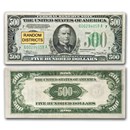$500 Dollar Bills 1928-1934
History of $500 Dollar Bills
Currency collection is often overlooked by numismatists, but with such a variety of large and small-type Federal Reserve Notes to choose from, collectible currency can be just as rewarding and valuable as collecting coins.The $500 bill holds a special place in the world of currency collecting, representing a unique and intriguing piece of monetary history. From a collector's perspective, the $500 bill offers a glimpse into the past and allows for a deeper understanding of the evolution of currency in the United States.
The $500 bill was first introduced in the late 19th century, during a time when larger denominations were commonly used for high-value transactions and interbank transfers. These bills were primarily issued as Federal Reserve Notes, featuring intricate designs and notable figures from American history. Their large size and distinctive appearance made them stand out among other denominations, adding to their appeal for collectors.
Notable $500 Bills
One of the most iconic $500 bills is the Series of 1918 Gold Certificate, often referred to as the "Giant Abraham Lincoln" due to its impressive size and portrait of the 16th U.S. President. This bill is highly sought after by collectors for its historical significance and aesthetic beauty. However, it is important to note that the $500 bill was last printed in 1945 and was officially discontinued in 1946, making it a rare and valuable piece to add to a collection.
Collector's Perspective
Due to their limited circulation and subsequent rarity, $500 bills have become highly sought after by currency collectors. Their scarcity and historical significance contribute to their appeal, and collectors are often willing to pay a premium to acquire these bills in good condition. The condition, age, and rarity of the bill are key factors that determine its value in the collector's market.
Collectors of $500 bills often find enjoyment in the pursuit of completing a set or acquiring bills with unique serial numbers, such as low numbers or repeating patterns. They may also appreciate the historical context associated with these bills, delving into research and discovering the stories behind the individuals and events depicted on the currency.

















